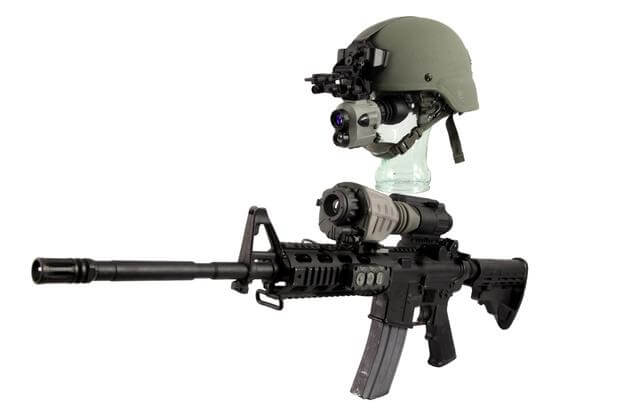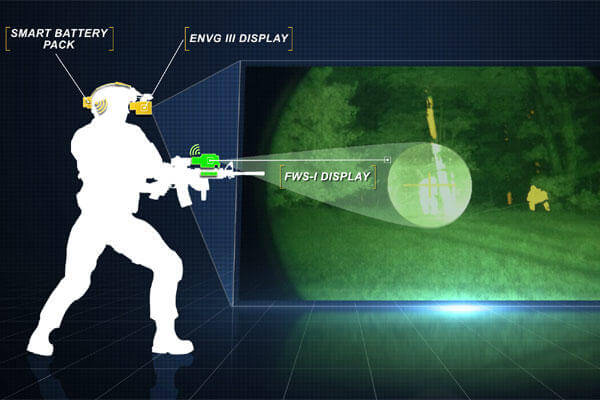The U.S. Army is working on a new weapon sight that will arm soldiers with a breakthrough technology for engaging enemy targets at night, Army engineers said.
In three years, the Army hopes to start fielding the Family of Weapon Sights-Individual, a new lightweight thermal weapon sight that is designed to communicate wirelessly with the service's latest Enhanced Night Vision Goggle (ENVG).
Linking these two technologies creates a new capability called Rapid Target Acquisition, according to Lt. Col. Timothy Fuller, product manager for Soldier Maneuver Sensors at Fort Belvoir, Va.
The FWS-I mounts on the M4 carbine or the M249 squad automatic weapon. At the push of a button, a soldier can wirelessly transmit the FWS-I's sight reticle into the wide display screen of the helmet-mounted ENVG III and quickly fire at the enemy target, Army officials said.
"I really think it's a leap-ahead capability," Col. Mike Sloane, Project Manager for Soldier Sensors and Lasers, told a group of reporters at a July 22 roundtable discussion.
The Army plans to start fielding 18 FWS-Is per infantry platoon in late 2018. It's being designed to weigh about 1.5 pounds and attach right in front of the standard daytime optics used on the M4 and M249.
What makes it special is it is designed to work specifically with the ENVG III, which the Army plans to field in 2017.
The service began fielding the first generation of the ENVG in 2009 and has since fielded a slightly improve version in the ENVG II.
The ENVG technology consists of a traditional infrared image intensifier similar to the older PVS-14 and a thermal camera. The system fuses the IR with the thermal capability into one display.
Soldiers can choose between IR, thermal or use both at the same time for an extremely effective tool for spotting enemy at night or during the day, Army officials said.
The Army plans to field 24 ENVG IIIs to each infantry squad. It weighs just under two pounds, the same as the ENVG II, but it offers improved resolution and is designed to receive a wireless signal from a device like the FWS-I.
Once an infantryman spots an enemy target with the ENVG III, he pushes a button on a small control panel attached to his weapon. This sends a wireless signal to the ENVG III's antenna. The signal then travels through a piece of fiber optic cable beneath his helmet cover to a smart battery pack at the rear of the helmet which houses a tiny processor, Fuller said.
The sight reticle then appears in the ENVG III's 40-degree wide display, allowing the shooter to quickly aim and fire his weapon.
The process is similar to using the current IR pointer soldiers mount to their weapons, said Fuller, but it doesn't create a signature that is visible to an enemy equipped with night-vision devices.
40-degree Field of View
"By transmitting that display into the ENVG III, the soldier … is able to maintain a wide, 40-degree field of view instead of going through a more narrow sight," Fuller said. "That gives them greater situational awareness if they need to transition to the next target."
The FWS-I has a range of 1,000 meters, which will give soldiers a significant advantage over the enemy, Sloane said.
The M4 doesn't reach that far, but having this range gives soldiers the ability to "shape the fight," he said.
"You will see the enemy and be able to see how you want to engage and destroy that enemy … before he can see you," Sloane said. "It is absolutely incredible."
The combo will also give shooters an edge against fog, smoke or sandstorms, Sloane said.
"Let's say there was smoke or some obscurant between the shooter and where you see the [enemy] soldiers out there," he said. With only image intensification, or infrared, "you would be blocked; you wouldn't be able to see it. Thermal allows the shooter to see targets as if there is no smoke."
As with past programs, Army engineers have communicated heavily with industry and with soldiers before the product is designed, Sloane said.
"When our soldiers deploy, anywhere, anytime around the world and they turn this piece of equipment on, it needs to work every single time … and that is very important," he said. "We spend a lot of time energy and money making sure that our equipment works all the time."
For the FWS-I and the ENVG III to be used effectively, infantry officials will need to develop new "tactics, techniques and procedures" which means additional training for infantry squads and platoons, according to Phil Cheatham, deputy branch chief for Electronics and Special Developments at the Maneuver Center of Excellence, located at Fort Benning, Ga.
"There is absolutely going to have to be additional training based on what the system does and how it operates," he said.
--Matthew Cox can be reached at matthew.cox@military.com






























